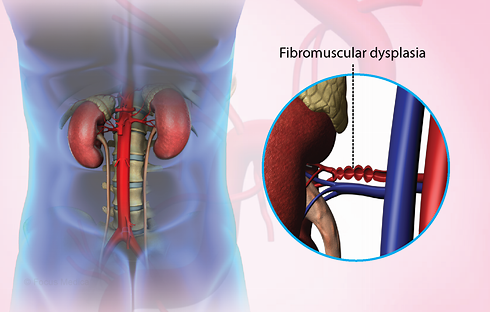What is fibromuscular dysplasia (FMD)?
Fibromuscular dysplasia (FMD) is a rare medical condition. It is a non-atherosclerotic, non-inflammatory vascular disease leading to arterial stenosis (blockage), aneurysm (abnormal bulges) and dissection (splitting) of small- to medium-sized arteries.
The most frequently affected arteries are renal (75- 80%) and cervical arteries (75%); but FMD has also been reported in carotid, vertebral, coronary, mesenteric and limb arteries. 30-50% have multiple arteries affected.

Who gets fibromuscular dysplasia (FMD)
Fibromuscular dysplasia (FMD) is a rare disease, and its exact prevalence is not known. It predominantly affects women, with a female-to-male ratio of about 9:1.
It represents less than 1:100 cases of renovascular hypertension (high blood pressure), renovascular disease, or renal artery aneurysms.
FMD is most commonly diagnosed in women between the ages of 30 and 50, although it can occur at any age, including in children and the elderly. Smoking may be associated with a more aggressive course of the disease.
Cause of fibromuscular dysplasia (FMD)
The cause of FMD is not known. A history of FMD in at least another relative is reported in around 4% of cases, suggesting a possible genetic component.
Symptoms of fibromuscular dysplasia (FMD)
Symptoms of FMD vary depending on which arteries are affected. They relate to decreased blood flow in affected areas.
- Hypertension – 67%
- Headache – 57%
- Pulsatile tinnitus – 33%
- Neck pain – 27%
- Cervical bruit – 25%
- Flank or abdominal pain – 17%
- Abdominal bruit – 11%
- TIA – 10%
- Stroke – 8%.
How FMD affects the kidneys has been reviewed here: Van Twist, 2018. And case reports are described here: Sperati, 2009 and Woodley-Cook, 2015.
Diagnosis of fibromuscular dysplasia (FMD)
FMD is typically diagnosed through imaging studies such as angiography, computed tomography angiography (CTA), or magnetic resonance angiography (MRA). A definitive diagnosis is made by identifying the characteristic arterial abnormalities.
It is important to look for an disease in other sites, e.g. if you have kidney FMD, you should be considered for a brain CT or MR angiogram, looking for cerebral aneurysms.
String-of-beads appearance.
One distinctive characteristic of FMD is the ‘string-of-beads’ appearance seen on angiograms or imaging studies. This refers to the alternating areas of narrowed and dilated arteries, giving the appearance of beads on a string.


String of beads appearance in renal arteries (renal angiogram).
There are more examples of angiograms here. Mounier-Vehier, 2002 has described the effects of FMD on the appearance of the kidneys.
Treatment of fibromuscular dysplasia (FMD)
Treatment for FMD depends on the location and severity of the disease, as well as the presence of symptoms.
- Medical management includes blood pressure control e.g. ACE inhibitors
- Anti-platelets may be used if the patient is at risk of stroke
- Percutaneous angioplasty – in contrast to patients with atheromatous renovascular disease, hypertension can be cured or improved by angioplasty. Angioplasty without stent insertion is usually sufficient
- If the patient has an aneurysm, this can be followed up with magnetic resonance angiography (MRA), rather than computerised tomography (CT) to reduce radiation exposure and follow the size of the aneurysm.
In some cases, intracranial aneurysm clipping, or surgery may be necessary to repair or bypass the affected arteries.
Complications of fibromuscular dysplasia (FMD)
If left untreated, FMD can lead to various complications, such as:
- Severe high blood pressure
- Renal artery stenosis
- Aneurysm rupture
- Stroke
- Myocardial infarction.
Can fibromuscular dysplasia cause chronic kidney disease (CKD)?
It can do, but this is unusual, and end-stage kidney disease (ESRD) is rare.
Summary
We have described what is fibromuscular dysplasia (FMD). We hope it has been helpful.
Other resources
There is more information on fibromuscular dysplasia (FMD) on the UK Kidney Association (UKKA) website here, and in these two review articles: Plouin, 2007 and Baradhi, 2023.
References
- Chothia MY, Davids MR, Bhikoo R. Awakening the sleeping kidney in a dialysis-dependent patient with fibromuscular dysplasia: A case report and review of literature. World J Nephrol. 2018 Nov 24;7(7):143-147. [PMC free article] [PubMed]
- Antonescu I, Knowles M, Wirtz E, Pascarella L. An Unusual Case of Bilateral Upper Extremity Ischemia Caused by Forearm Vessel Fibromuscular Dysplasia. Ann Vasc Surg. 2019 Apr;56:353.e7-353.e11. [PubMed]
- Oliva-Damaso N, Costa-Fernandez J, Oliva-Damaso E, Bravo-Marques R, Lopez F, Del Mar Castilla M, Sequeira J, Payan J. Kidneys are key in secondary hypertension: a case of fibromuscular dysplasia. Lancet. 2018 Nov 24;392(10161):2298. [PubMed]
- Aday AW, Kreykes SE, Fanola CL. Vascular Genetics: Presentations, Testing, and Prognostics. Curr Treat Options Cardiovasc Med. 2018 Nov 13;20(12):103. [PMC free article] [PubMed]
- Narula N, Kadian-Dodov D, Olin JW. Fibromuscular Dysplasia: Contemporary Concepts and Future Directions. Prog Cardiovasc Dis. 2018 Mar-Apr;60(6):580-585. [PubMed]
- Jinnouchi H, Finn AV, Virmani R. Nonatherosclerotic Vascular Disease in Women. Tex Heart Inst J. 2018 Aug;45(4):233-235. [PMC free article] [PubMed]
- Kong W, Hu Z. Unique imaging findings in fibromuscular dysplasia of renal arteries: A case report. Medicine (Baltimore). 2018 Nov;97(46):e12815. [PMC free article] [PubMed]
- Ko M, Kamimura K, Ogawa K, Tominaga K, Sakamaki A, Kamimura H, Abe S, Mizuno K, Terai S. Diagnosis and management of fibromuscular dysplasia and segmental arterial mediolysis in gastroenterology field: A mini-review. World J Gastroenterol. 2018 Aug 28;24(32):3637-3649. [PMC free article] [PubMed]
- Persu A, Van der Niepen P, Touzé E, Gevaert S, Berra E, Mace P, Plouin PF, Jeunemaitre X., Working Group “Hypertension and the Kidney” of the European Society of Hypertension and the European Fibromuscular Dysplasia Initiative. Revisiting Fibromuscular Dysplasia: Rationale of the European Fibromuscular Dysplasia Initiative. Hypertension. 2016 Oct;68(4):832-9. [PubMed]
- Cunningham TK, Draper H, Rajesh U. Management of a pregnancy with underlying fibromuscular dysplasia with a history of stroke and carotid artery dissection. J Obstet Gynaecol. 2019 Apr;39(3):417-419. [PubMed]
Last Reviewed on 21 November 2023

